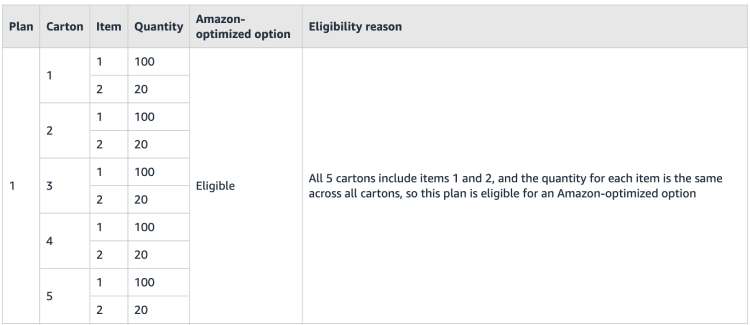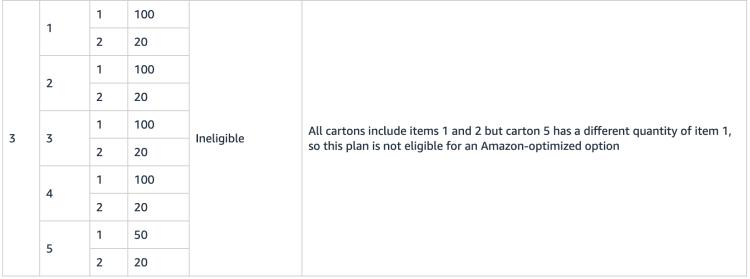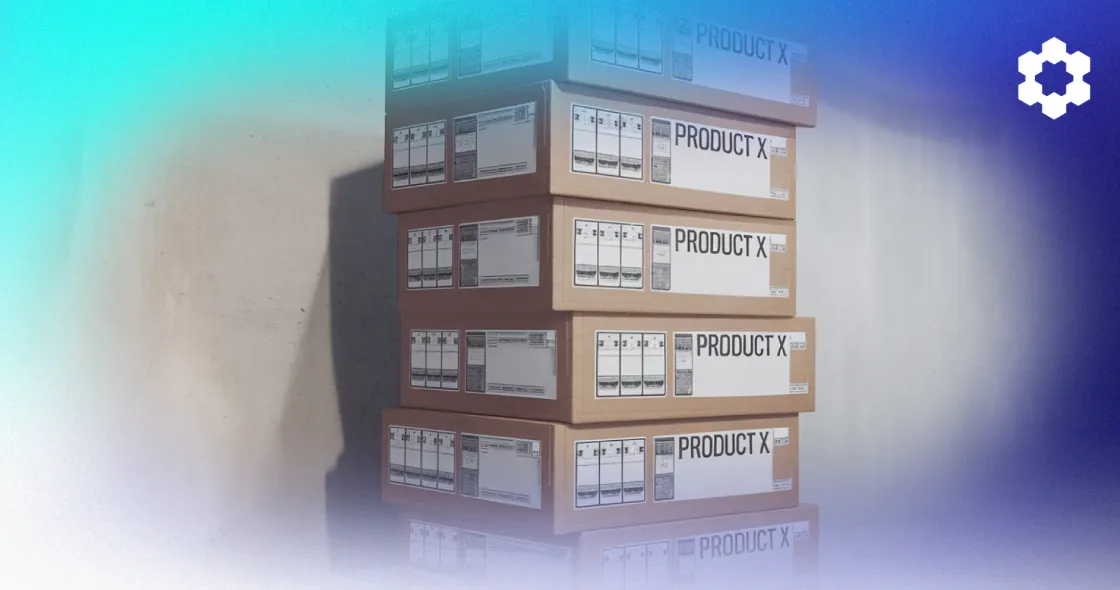Breaking Down Amazon’s Shocking New Inbound Placement Fee Update
Amazon has just announced its latest update to the Inbound Placement Service Fee policy. This isn’t just another minor tweak – it’s a big change that could have a notable impact on third-party sellers and their bottom line.
“To qualify for the Amazon-optimized inbound option with no inbound fee, your shipments must include at least five identical cartons or pallets per item. Each carton or pallet must contain the same quantity per item and the same item mix.”
– Amazon Seller Central
While inbound placement fees aren’t new, the latest update includes a crucial modification that may make it difficult for many sellers to avoid hefty new charges.
Fortunately, we have an inventory management tool designed to help you navigate or reduce the impact of Amazon’s inbound placement service fee on your business.
The “Five Identical Boxes” Requirement: A Game-Changing Twist

The most jarring change in the policy is the new requirement for “five identical boxes” to qualify for the Amazon-optimized shipment splits option with lower or no inbound fee.
The availability of the Amazon-optimized option depends on several factors like product types, geographical demand, and potentially any undisclosed criteria. So, while you could meet all these conditions, you may still not see an option for optimized or fee-free inbound shipments.
Other things to consider:
- Partial or Amazon-optimized shipment splits: Sellers can send inventory to multiple inbound locations for a reduced fee or no fee.
- Qualification criteria: To qualify for the no-fee Amazon-optimized option, shipments must now include at least five identical cartons or pallets per item. This means the same product (item) needs to be packed in the same number of units across each of these cartons or pallets.
- Same quantity per item: Amazon’s not always one for clarity in policy. True to form, there is some ambiguity in the way “each carton or pallet must contain the same quantity per item and the same item mix” is written. Specifically, it’s unclear whether this applies only to the five (5) required cartons or pallets or to all cartons in the entire shipment.
Our interpretation is that as long as you have 5 identical cartons or pallets with the same quantity and item mix, you should be allowed to include additional cartons or pallets with different configurations. For example, you could have five boxes with 100 units each and two more boxes with 50 units, while still qualifying for the Amazon-optimized shipment split option.
However, the alternative interpretation is that every single carton or pallet in the shipment must be identical, which would be more restrictive. Based on the current wording, we believe the former is more likely, but real-world application may confirm or refute this.If we find any further clarification or updates on this rule, we will provide a more definitive explanation in this article.In addition, if you only send four cartons, even if each is identical, you won’t qualify for the Amazon-optimized shipment splits, and you may incur inbound placement fees. The key is ensuring that at least five cartons are identical in both size and content to avoid these fees. - Same item mix: The item mix must be the same for at least five pallets or cartons, rather than requiring every single carton or pallet in your shipment to be identical. For instance, if this interpretation is correct, pallet #6 and beyond wouldn’t need to match the first five pallets exactly.
- Partial splits option: If you choose to send inventory to a partial number of inbound locations (usually two or three), you’ll pay a reduced fee as compared to the minimal shipment splits option which allows you to send inventory to as few locations as possible (often only a single location).
How Does the Five Box Rule Affect Less Than Load (LTL) Shipments?
You might be wondering how Amazon’s new rule applies to your inbound shipments, especially when it comes to pallets and LTL shipments.
The requirement for “five identical cartons or pallets per item” can seem a bit unclear at first. Are you expected to have five pallets per item for LTL shipments, or does the rule apply within a pallet, as suggested by some of the examples?
According to the policy, to qualify for the Amazon-optimized inbound option without incurring an inbound fee, “your shipment must contain at least five identical cartons or pallets per item. Each carton or pallet must contain the same quantity per item and the same item mix.”
In the case of LTL shipments, if you’re sending pallets, you need at least five pallets that have the same mix of products (identical item mix and quantities on each pallet). However, this does not mean that you need five (5) whole pallets of the same product. You can have a mix of products on each pallet, as long as the same mix and quantity are replicated across all five pallets.
If you are shipping three (3) different products, you could pack them on each pallet with the same quantities (e.g., 50 units of Product A, 30 units of Product B, and 20 units of Product C per pallet). As long as all five pallets have the same number and mix of items, you would meet the qualification.
If you don’t meet this requirement, you may still qualify for “Partial Shipment Splits” at a reduced fee, but you would need to send your inventory to two or more inbound locations.
This rule aims to streamline the inbound process by encouraging sellers to optimize their shipments, making it easier for Amazon to manage inventory distribution efficiently. However, it can create challenges, especially for smaller sellers who don’t deal in high-volume shipments or have a diverse product range.
Potential Benefits of Meeting Amazon’s Five Box Rule
For sellers who regularly ship large quantities of the same item, the Amazon-optimized option can streamline logistics and minimize fees. By meeting the criteria of sending at least five identical cartons or pallets per item, they can avoid inbound placement fees altogether. This is particularly advantageous for those who focus on a few high-volume products, as they can efficiently pack their shipments and send them to multiple Amazon fulfillment centers without worrying about extra costs.
For example, if a seller consistently ships 100 units of a best-selling kitchen gadget, they can easily divide these into five identical cartons, each with 20 units. By doing so, they qualify for the Amazon-optimized shipment splits, ensuring their products are distributed across multiple fulfillment centers at no additional cost. This not only saves money but also helps ensure that the products are closer to customers, potentially improving delivery times and customer satisfaction.
Additionally, the partial splits option, which allows sellers to send inventory to a reduced number of inbound locations for a lower fee, can also benefit those who want to balance cost savings with logistical efficiency. This is especially useful for sellers with regional demand, as it allows them to optimize their inventory distribution without incurring the full placement fee.
Overall, sellers who can meet the Amazon-optimized placement criteria stand to gain from lower fees, better inventory distribution, and potentially faster delivery times, making it an attractive option for those who can align their operations with these requirements.
FBA Inbound Placement Service Eligibility Guideline



The Hidden Costs: How This Update Could Drain Your Profits
This new rule requiring at least five identical cartons or pallets per item to qualify for the Amazon-optimized option could create significant logistical challenges for some sellers, particularly smaller sellers with limited shipping budgets and those with diverse product lines.
If a seller only has a small quantity of a product to send, they may not be able to fill five cartons. This forces them to either overproduce or ship fewer products in more costly, non-optimized ways (or minimal shipment splits), resulting in higher inbound placement fees.
Note: When shipping inventory to a single location, expect to pay $0.21 to $0.68 per unit fee for standard size and $2.16 to $6.00 for large bulky products.
Here’s an example that illustrates how not qualifying for Amazon-optimized shipment splits might impact smaller sellers.
Small Seller with a Single Product Line
- Product: Small standard-size item (e.g., a phone case)
- Shipment: 500 units, each weighing 8 oz
- Carton Packing: 50 units per carton (10 cartons total)
Amazon-Optimized Shipment Splits (No Fee)
- Five identical boxes
- Fee per unit: $0
- Total fee: $0
Partial Shipment Splits (Two or Three Locations)
- Fee per unit: $0.12 to $0.21
- Total fee: $60 to $105 per shipment
Minimal Shipment Splits (Single Location)
- Fee per unit: $0.21 to $0.30
- Total fee: $105 to $150 per shipment
If the seller does not qualify for Amazon-optimized shipment splits and instead incurs partial or minimal placement fees, the profit per unit drops by $0.12 to $0.30. While this might seem small per unit, it adds up significantly with higher volumes.
For example, on a shipment of 1,000 phone cases, the seller would lose $120 to $300 in profits depending on the fees incurred. This reduction in profit can be substantial, especially for those operating on thin margins. It highlights the importance of qualifying for the Amazon-optimized shipment splits to maintain profitability.
For sellers with diverse product lines, the challenge is even greater. These sellers often send a variety of products in smaller quantities, making it difficult to meet the five-carton requirement for each item.
To avoid fees, they would need to either increase the number of units per product (which may not align with demand) or consolidate shipments in ways that could disrupt their usual operations.
Both scenarios can lead to higher costs, inefficient inventory management, and potential delays in getting products to Amazon’s fulfillment centers.
Amazon’s solution?
A fully-managed, end-to-end supply chain program designed to streamline inventory management, shipping, and fulfillment for US sellers.
Announced September 18th at the 2024 Amazon Accelerate event, this new service allows sellers to entrust Amazon with the entire supply chain process, from factory pickup to delivery at FBA warehouses.
For sellers using Amazon’s supply chain solution, this means simplified logistics, improved delivery speeds, and reduced shipping costs. Sellers opting into the fully managed service can benefit from a:
- 25% discount on Amazon Warehousing and Distribution (AWD) storage fees.
- 15% off transportation costs, with some reporting a 20% boost in sales conversion.
- The service helps businesses reduce their total stock needs by an average of 20% through consolidating inventory into a single pool, further improving efficiency.
However, for those not utilizing Amazon’s supply chain solutions, these changes may present challenges. Amazon’s new policies, such as the “five-box rule” for inbound shipments, create logistical hurdles for smaller sellers or those with a wide product range. If sellers don’t meet the five-box rule requirements, they may need to send inventory to multiple inbound locations, incurring fees.
Amazon’s increasing control over sellers’ logistics might not suit businesses that already have efficient supply chains managed by freight forwarders or prefer to avoid dependence on Amazon.
Ultimately, while the new supply chain solution offers benefits for sellers seeking more efficient inventory management and reduced costs, those not using Amazon’s program may need to reevaluate their strategies to stay competitive under these new logistics rules.
Survival Strategies: Counteracting Amazon’s Latest Curveball
To navigate these treacherous waters, consider these critical strategies:
- Optimize your inventory levels: Meticulously analyze your sales data to ensure you’re sending the right quantities to Amazon.
- Consolidate shipments: Where possible, strategically group items to meet the five-carton requirement. This way, you can avoid the fees with the ones that have five cartons, and then use the money saved on the fee-free shipment on a smaller subset of inventory that doesn’t fit the five-carton requirement. This may help reduce your overall fees by not paying for all inventory just because a few ASINs have less than five.
- Reassess your product mix: Consider a tactical adjustment of your product offerings to better align with the new policy.
- Explore alternative fulfillment methods: Evaluate if other fulfillment options like FBM or Seller Fulfilled Prime might be more cost-effective for certain products.
- Leverage cutting-edge inventory management tools: Utilize advanced software solutions to help optimize your inventory and shipping strategies.
Your Secret Weapon: How SoStocked Can Shield You from Fee Hikes
In this new, high-stakes environment, effective inventory management isn’t just important – it’s survival. SoStocked, a state-of-the-art inventory management solution, offers several powerful features that can help you not just survive, but thrive under the new inbound placement fee policy.
- Advanced Forecasting: Predict demand with pinpoint accuracy to optimize your inventory levels and shipment sizes.
- Inventory/Marketing Sync: Seamlessly align your inventory strategy with your marketing efforts to ensure you’re sending the right quantities to Amazon.
- Capacity Manager: Managing capacity limits involves not just packing strategies but also understanding and configuring the units per carton and minimum transfer quantity settings. While the Capacity Manager feature might not directly apply to inbounding, it plays a crucial role in managing overall capacity constraints imposed by Amazon, especially during peak season. Sellers must consider how these limits will affect their ability to ship products in compliance with the new rules. For instance, if Amazon imposes strict limits on the number of units or cartons that can be stored or shipped per fulfillment center, you will need to adjust your inventory strategies to avoid overloading your FBA capacity and incurring additional fees.
- Actionable Command Center: Receive real-time alerts and strategic recommendations to help you make informed decisions about your inventory and shipments.
- Multi-Location Management: Efficiently manage inventory across multiple locations to optimize your inbound shipments like a pro.
- Carton/Pallet Optimization: Leverage SoStocked’s master carton calculator to optimize your packaging and meet Amazon’s new requirements with ease.
By harnessing these powerful strategies, you can make data-driven decisions to minimize the impact of the new inbound placement fee policy on your business and stay ahead of the competition.
Urgent Action Items: What Sellers Must Do Now
- Conduct an emergency review of your current inventory and shipping practices in light of the new policy.
- Assess the potential financial impact of these changes on your business, including detailed cost calculations.
- Immediately consider implementing new strategies or tools to optimize your inventory management.
- Stay vigilant and informed about any further updates or clarifications from Amazon regarding this policy.
- Explore how cutting-edge inventory management solutions like SoStocked can help you adapt to these changes and safeguard your profitability.
As Amazon continues to shake up the playing field, agility and information are your best weapons. Understanding these changes and leveraging the right tools and strategies can help you navigate this new landscape and continue to thrive on the Amazon, even as others falter.
Don’t let Amazon’s new policy catch you off guard! Get started with SoStocked today and arm yourself with the tools you need to outsmart these fee hikes and keep your profits intact.




